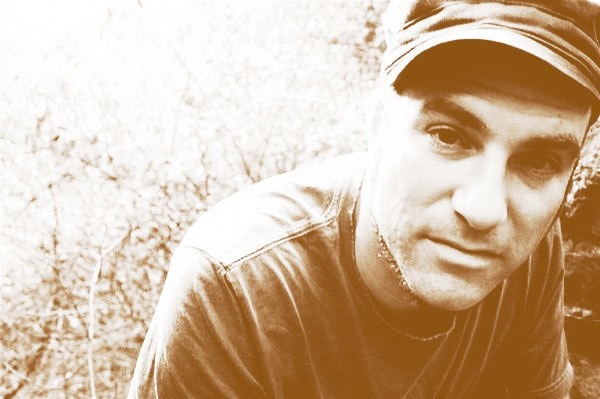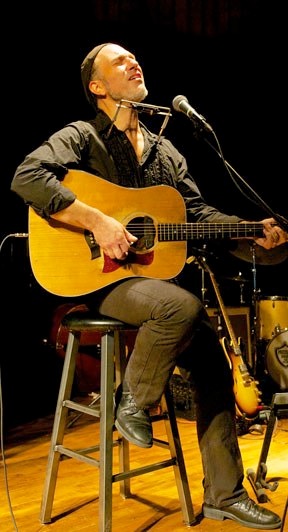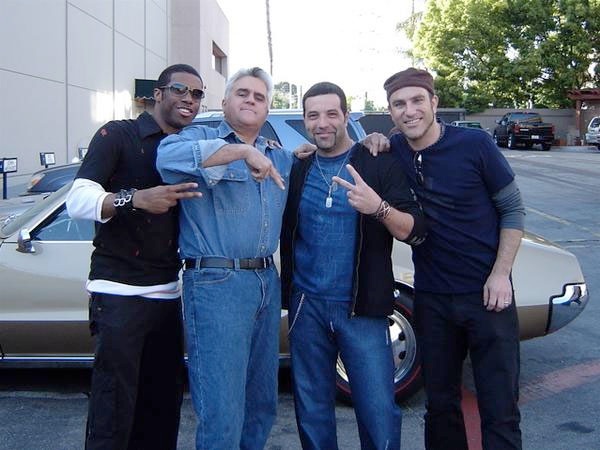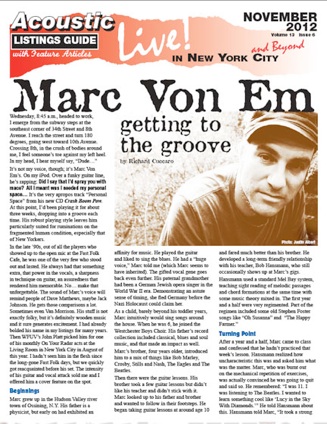Marc Von Em
getting to the groove
By Richard Cuccaro

Wednesday, 8:45 a.m., headed to work, I emerge from the subway steps at the southeast corner of 34th Street and 8th Avenue. I reach the street and turn 180 degrees, going west toward 10th Avenue. Crossing 8th, in the crush of bodies around me, I feel someone’s toe against my left heel. In my head, I hear myself say, “Dude…”
It’s not my voice, though; it’s Marc Von Em’s. On my iPod. Over a funky guitar line, he’s rapping: Did I say that I’d spray you with mace? All I meant was I needed my personal space… It’s the very apropos track “Personal Space” from his new CD Crash Boom Pow. At this point, I’d been playing it for about three weeks, dropping into a groove each time. His robust playing style leaves him particularly suited for ruminations on the fragmented human condition, especially that of New Yorkers.
In the late ’90s, out of all the players who showed up to the open mic at the Fast Folk Cafe, he was one of the very few who stood out and lasted. He always had that something extra, that power in the vocals, a sharpness in technique on guitar, an assuredness that rendered him memorable. No… make that unforgettable. The sound of Marc’s voice will remind people of Dave Matthews, maybe Jack Johnson. He gets those comparisons a lot. Sometimes even Van Morrison. His stuff is not exactly folky, but it’s definitely wooden music and it sure generates excitement. I had already bolded his name in my listings for many years. Then WFUV’s John Platt picked him for one of his monthly On Your Radar acts at the Living Room in New York City in August of this year. I hadn’t seen him in the flesh since the long-gone Fast Folk days, but we quickly got reacquainted before his set. The intensity of his guitar and vocal attack sold me and I offered him a cover feature on the spot.
Beginnings
Marc grew up in the Hudson Valley river town of Ossining, N.Y. His father is a physicist, but early on had exhibited an affinity for music. He played the guitar and liked to sing the blues. He had a “huge voice,” Marc told me (which Marc seems to have inherited). The gifted vocal gene goes back even further. His paternal grandmother had been a German Jewish opera singer in the World War II era. Demonstrating an astute sense of timing, she fled Germany before the Nazi Holocaust could claim her.
As a child, barely beyond his toddler years, Marc intuitively would sing songs around the house. When he was 6, he joined the Westchester Boys Choir. His father’s record collection included classical, blues and soul music, and that made an impact as well.
Marc’s brother, four years older, introduced him to a mix of things like Bob Marley, Crosby, Stills and Nash, The Eagles and The Beatles.
Then there were the guitar lessons. His brother took a few guitar lessons but didn’t like his teacher and didn’t stick with it. Marc looked up to his father and brother and wanted to follow in their footsteps. He began taking guitar lessons at around age 10 and fared much better than his brother. He developed a long-term friendly relationship with his teacher, Bob Hansmann, who still occasionally shows up at Marc’s gigs.
Hansmann used a standard Mel Bay system, teaching sight reading of melodic passages and chord formations at the same time with some music theory mixed in. The first year and a half were very regimented. Part of the regimen included some old Stephen Foster songs like “Oh Susanna” and “The Happy Farmer.”
Turning Point
After a year and a half, Marc came to class and confessed that he hadn’t practiced that week’s lesson. Hansmann realized how uncharacteristic this was and asked him what was the matter. Marc, who was burnt out on the mechanical repetition of exercises, was actually convinced he was going to quit and said so. He remembered: “I was 11. I was listening to The Beatles. I wanted to learn something cool like ‘Lucy in the Sky With Diamonds.’” He told Hansmann about this. Hansmann told Marc, “It took a strong kid to hold out for a year and a half.” He immediately switched gears and prepared a blues song for Marc to learn and worked out a Beatles song as well. It breathed new life into Marc’s dedication and he left feeling that he wanted to study and play music forever. From then on they would mix pop music into the learning process.
Evolving Guitars
Before he got his first guitar, Marc’s father actually rented a guitar for over a year for him to use. “It was awful — really high action,” Marc said. I forgot to ask what kind, but I pictured the cheap Stella I had as a kid. The strings on mine were so high off the fret board, I quit (much to my regret later) because my fingers hurt. A cheap guitar would not stop Marc, though. He continued learning from early Beatles albums like Rubber Soul, experimenting with chords and guitar runs. He also began writing and had his first five songs in the bag by the time he was 14.
When he got to the eighth grade, he collaborated with other young musicians, finding a drummer and bass player. At 13 he got an amplifier for Christmas so he bought an electric pickup for his acoustic guitar. A year later he got his first electric guitar.
Rock ’n’ Roll Kids
Going into high school, Marc had a power trio. He got a distortion pedal and experimented with “throwback” rock stuff, a lot of covers by ’60s groups like Led Zeppelin. They did “Dazed and Confused,” “Whole Lotta Love” and “Limelight” (Rush), getting as close as they could to the originals. They played in a couple of bars to enthusiastic reception until the owners stopped it to avoid problems with under-age laws. They did a couple of “battle of the bands” competitions in school — one each in his sophomore and junior years. They also played at some block parties, outdoor flea markets, an Ossining fair and a birthday party. Marc wrote songs all through high school, though many were not suitable for the rock group he was in.
The music Marc was playing at the time was a mash-up of Beatles, Pink Floyd and Yes, who he also liked. Chords his guitar teacher taught him using the Mel Bay system would get used, perhaps by moving fret positions. He’d find that certain changes would create similar sounds to the aforementioned groups, and he’d use them in his band’s material.
Late in his junior year of high school, Marc dropped out of the band and concentrated on solo guitar, preparing for a college music school. There were the typical college entrance requirements and, in addition, a music school audition to prepare for. He studied a lot of classical and jazz guitar with Mr. Hansmann. In preparation, he learned things I never heard of, like Fernando Sor Study No. 1 & 5 from a book of studies for classical guitar. He also prepared a jazz number, the name of which he couldn’t recall.

The College Crucible
Marc applied to The Hartt School of Music, Dance and Theater in Hartford, Conn., The New School in Manhattan and the Ithaca College School of Music. He chose Ithaca after he graduated high school in 1986.
The atmosphere at Ithaca was competitive. Students had to pass auditions every year. The curriculum was dense, providing Marc with a very deep toolbox. There were six semesters in music theory. He remembers a course in sight reading where, in the final exam, the student was expected to see and play sharp and flat notes placed in odd places in a random test piece. Unlike some of his classmates, Marc liked a movement class where the student had to clap and step in different rhythms, ingraining the music on a physical level. His sense of rhythm is so strong that it would seem he’d have a real affinity for this class. He feels that it has helped his performance skills. I’d have to agree.
During college Marc gravitated toward musicians he enjoyed playing with. He belonged to a band that went through two or three different incarnations. He played guitar in tandem with a bassist, a man on keyboards and a drummer. They’d perform covers, but wrote a lot of their own material (about half by Marc). They played a mixture of rock and funk. Some compositions were similar to Yes material, but other pieces diverted into James Brown/Maceo Parker-like stuff.
He’s still friends with the bassist of that college band, John DeCrescente, who played bass on Crash Boom Pow. They’ve been “on-and-off partners for a long time,” he told me. During that time, Marc experimented with a wah-wah pedal and played around with progressive, blues and traditional progressions.
College was broadening in other ways. Marc was exposed to a student community that was eclectic, comprised of a mix of suburban, Midwestern and hippie types. Then there was the town of Ithaca, which had small and mid-size music venues. The national touring acts that came through included the Spin Doctors, Blues Traveler and, early in its career, Phish.
Although his voice has been his strongest asset, Marc did not actually study voice. He sang in choral and a cappella groups in college and got general advice on breathing from the choral director. On top of his natural ability, he finally took voice lessons in his late 20s, which helped with “placing” his voice, he said.
Marc finished his college career with a B.A. in musical performance in classical guitar. He’d never be able to actually perform as a classical guitarist, he told me. Ithaca simply prepared him for a long and diverse career.
Growing Pains
For the first five years after getting out of school, Marc didn’t care how he made money. He just wanted to play music on nights and weekends. He worked a variety of jobs, including as cashier in an A & P, and as a roofer’s helper. Carrying hundred-pound batches of shingles up long ladders was perilous, and protruding nails on stripped rooftops were hell on the flimsy shoes he wore. He also did housepainting and landscaping.
He did a stint in a cover band, which made money, but he found it wasn’t getting nearer his goal of being an original solo artist.
Around 1997-98 he wanted to start finding himself and performed solo at a number of venues including The Fast Folk Cafe open mic, where I first encountered him.
Although he played a lot of rock music, he continued to expand his skills with the acoustic guitar, using it for his songwriting.
Von Em, the Band
In the late ’90s he established a trio called Von Em. It included Marc on acoustic guitar, a bassist and a hybrid drummer-percussionist. The band initially took off with a roar. They toured the East Coast and opened for acts like The Mamas and the Papas and The Young Rascals. They played some big venues like The Paramount Theater in Peekskill, N.Y., and Big Birch Pavilion in Patterson, N.Y. — part of a ski area — during that time
Their manager helped them get their CD, Von Em, distributed to publishing houses. One of them, McHale Barone, liked the sound and brought the band in to rearrange a Budweiser jingle, getting the Von Em sound on “This Bud’s for You.” It premiered during the 2000 Superbowl broadcast and aired for two years. I mentioned that it probably bought him a few sets of tires for the car. Marc laughingly agreed, joking that he might have thought, “I can buy FIVE falafels today!” He also wrote a jingle for HIP insurance and a few others.
Marc broke up the band when he felt it wasn’t progressing the way he wanted it to. He also felt the desire to work solo tugging at him and had been mixing in solo gigs during that time.
Not So Lonely at the Top
Life took a quantum leap upward when Marc was asked to be a backup singer and guitarist for Rob Thomas, the lead singer for Matchbox 20. Rob released a solo CD in 2005 and Marc would support him on the tour for the album. While Von Em had played to 500-1,000 concert-goers, the Rob Thomas tour was a whole other beast. The Thomas band played in front of 4,000 people for Rob’s solo shows. For larger, special-event, multi-band shows with groups such as No Doubt and The Black-Eyed Peas, sponsored by Z-100 fm, there were audiences of 30,000. When they played Live 8 in Philadelphia, counting cable viewers, the audience was more than two million. They did the big TV talk shows: David Letterman, Jay Leno, and Ellen DeGeneres. They also toured in Europe and Australia. Planned off-days allowed Marc to soak in certain locales. Coming down off of that high perch, though was necessary for Marc to realize his dream of being a creative solo act.

Making it Work
Some of the ways that musicians find to ply their craft come outside of performing. Marc credits Hudson Valley performer Kathleen Pemble for turning him on to early childhood music. Marc now has included children’s music in his written work. He also has given guitar lessons. The jingle writing also has played a role.
The Recordings
Marc recorded three albums before Crash Boom Pow. They include Von Em, Free and Live at Rockwood (the first recorded there).
Marc lives in Dingmans Ferry, Pa. now but had moved to New York City after graduation and experienced firsthand, the intensity and craziness of city life which led to expression in song.
Crash Boom Pow fuses an intensity of rhythm and melody to create a groove that is impossible for the listener to ignore. It seems to make use of everything in Marc’s very deep toolbox and has the best examples of the vagaries of human interaction. The title track, “Crash Boom Pow,” conjures up cinematic imagery, but not so specific that it dictates a story line. It presents a “collage of images” gathered from Marc’s time in New York City. It allows listeners to have their own reactions and pictures. There are snippets of volatility: Dishes in the air glass and silverware / You can hear the noise five doors down it goes / Crash Boom Pow they keep breaking up / Crash Boom Pow they keep breaking up. Parts of the song, though, deal with life on the road: Travel with a suitcase, travel to a new place / Uh oh the money’s gone, uh oh the moneys gone / Uh oh the money’s gone, no time for redemption. There’s a syncopation that captures the uneven nature of relationships and a minor key melody expressing a pessimism in outcomes.
“Personal Space,” mentioned at the outset of this article, is a reaction to the crowded nature of life today and the generally competitive nature of people. Even in the small country town where he’s living now, he’s watched people “get crazy” at the deli counter, Of course, as a musician, he’s done a lot of highway time and has experienced the antics of bozos on the road: So I’m drivin’ down the road and this dude’s up on my butt / he keeps ridin’ my bumper ridin’ my bumper / I said man what the ____ / You know I can’t drive any faster than the dude that’s in front of me / or the girl that’s in front of him and so on and so forth and so on… It’s all too familiar. The steady, insistent throb of this piece works its way under the listener’s skin.
Marc likened “Who Are All These People” to “Crash Boom Pow” in its kaleidoscope of imagery. It has elements of funk and jazz in the melody that I always find refreshing in singer/songwriter fare, but beyond New York and jazz, I think it contains a different source of inspiration. “All these people” just might be those who acted as guideposts on Marc’s journey. Birdland plays Satchmo / You never slow down you never grow old / Got busy when he hit the modes / Maceo Parker played till dawn and won the King’s daughter / All the horses all the King’s men couldn’t change her opinion / But then one day Maceo did play James Brown come and take him away / He got busy when he hit the stage / Who are all these people Who are all these people in my house…
If readers want to experience something truly dynamic and exciting, they’ll head for a Marc Von Em gig to experience the groove, and become another one of those “people in” his “house.”
Website: marcvonem.com
Upcoming performances include:
Nov 2 10pm w/band Krogh’s, 23 White Deer Plaza, Sparta, NJ,
973.729.8428 FREE
3 2pm Bashakill Vineyards, 1131 South Road, Wurtsboro, NY,
845.888.5858 FREE
9 1:45am Acoustic Live guerrilla showcase, Northeast Regional Folk
Alliance, Hudson Valley Resort & Spa, Kerhonkson, NY
16 7pm Landmark Inn, 526 State Route 94 North, Warwick, NY,
845.986.5444
23 8pm 12 Grapes Music and Wine Bar, 12 North Division St.,
Peekskill, NY, 914.737.6624 $TBA
Dec 1 2pm Bashakill Vineyards, 1131 South Road, Wurtsboro, NY,
845.888.5858
2 2pm Warwick Valley Winery 114 Little York Road, Warwick, NY,
845.258.4858

